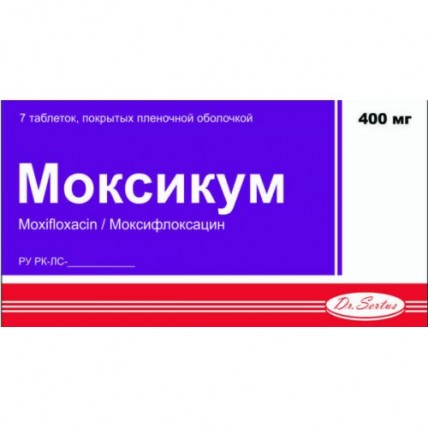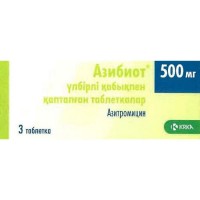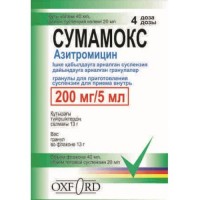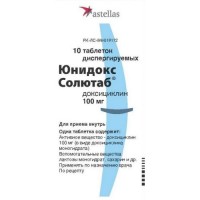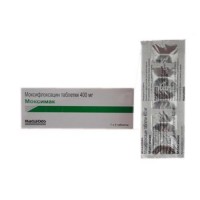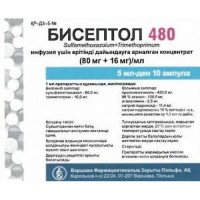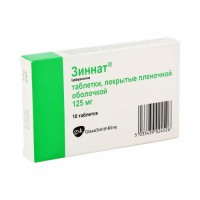Moksikum 7's 400 mg film-coated tablets
- $36.30
Instruction for medical use of Moksikum Torgovoye medicine name Moksikum Mezhdunarodnoye unlicensed name Moxifloxacin Dosage Form of the Tablet, film coated. Structure One tablet contains active agent – a moksifloksatsin a hydrochloride (it is equivalent to a moksifloksatsin of 400 mg). excipients: cellulose microcrystalline (PH 102), sodium of starch stearate, ethanol, water purified glikolit (Type A), Mannitolum, magnesium. Structure of a cover: opadr II pink 85F240036 (polyvinyl alcohol, titan E171 dioxide, polyethyleneglycol/macrogoal, talc, ferrous oxide red E172, ferrous oxide yellow E172). Description. Tablets of oblong shape, with a biconvex povernost, film coated pink color Pharmacotherapeutic group Antibacterial drugs for system use. Antimicrobial drugs – derivatives of a hinolon. Ftorkhinolona. Moxifloxacin. The ATX J01MA14 code the Pharmacological Pharmacokinetics Absorption At properties intake drug quickly and almost is completely soaked up from the digestive tract (DT), meal has no considerable impact on degree and speed of system absorption. After single dose of 400 mg of a moksifloksatsin the maximum concentration in blood plasma is reached within 0.5-4 hours and makes 3.1 mg/l. The absolute bioavailability is nearly 90%. Distribution Moxifloxacin is very quickly distributed in the extravasated course. Distribution volume – 1.7-2.7 l/kg. Linking with serum proteins (mainly with albumine) makes about 30-50% and does not depend on concentration of substance. The high concentrations of drug exceeding those in plasma are created in pulmonary fabric (including in alveolar macrophages), mucous membranes of bronchial tubes and nasal bosoms, in exudate from the center of skin inflammation. In saliva and in interstitial liquid high concentration of drug in a stand-at-ease is defined. Besides, high concentrations of drug are defined in abdominal organs and peritoneal liquid and also in female genitals. Metabolism After passing of the 2nd phase of biotransformation moxifloxacin is brought out of an organism by kidneys and a GIT both in not changed look, and in the form of inactive sulpho compounds (M1) and glucuronides (M2). Moxifloxacin is not exposed to biotransformation the microsomal system of P450 cytochrome. Removal Elimination half-life of drug makes about 12 hours. About 45% of a moksifloksatsin are brought in an invariable look (out of them about 20% with urine, about 25% with excrements). The general seeming clearance – 12 ± 2.0 l/h, renal – 2.6 ± 0.5 l/h. A pharmacodynamics Moksikum – bactericidal antibacterial drug of a broad spectrum of activity of a ftorkhinolonovy row. Inhibits topoisomerase II (DNK-giraza) and topoisomerase IV - the enzymes necessary for replication, a transcription, reparation and recombination of bacterial DNA. The inhibition of function of isomerases leads to irreversible changes in a bacterial cell and its death. The minimum bactericidal concentration almost do not differ from the minimum overwhelming concentration. There is no cross resistance with penicillin, cephalosporins, aminoglycosides, macroleads and tetracyclines. General frequency of development of stability low. The immunity to a moksifloksatsin develops slowly as a result of a number of consecutive mutations. Between drugs from group of ftorkhinolon the cross resistance, however some gram-positive and anaerobic microorganisms resistant to other ftorkhinolona is observed are sensitive to a moksifloksatsin. Moxifloxacin is active concerning a wide range of gram-negative and gram-positive microorganisms, anaerobe bacterias, acid resisting bacteria and atypical forms, such as Mycoplasma, Chlamydia, Legionella and also the bacteria resistant to β-laktamny and makrolidny antibiotics. The range of antibacterial activity of a moksifloksatsin includes the following microorganisms: gram-positive - Streptococcus pneumoniae (including the strains resistant to penicillin, and strains with multiple resistance to antibiotics) *, Streptococcus pyogenes (group A) *, Streptococcus milleri, Streptococcus mitis, Streptococcus agalactiae *, Streptococcus dysgalactiae, Streptococcus anginosus *, Streptococcus constellatus *, Staphylococcus aureus (including strains, sensitive to Methicillinum) *, Staphylococcus cohnii, Staphylococcus epidermidis (including strains, sensitive to Methicillinum), Staphylococcus haemolyticus, Staphylococcus hominis, Staphylococcus saprophyticus, Staphylococcus simulans, Corynebacterium diphtheria, Enterococcus faecalis (only the strains sensitive to Vancomycinum and gentamycin) *, gram-negative - Haemophillus influenzae (including the strains which are producing and not producing β-lactamelements) *, Haemophillus parainfluenzae *, Klebsiella pneumoniae *, Moraxella catarrhalis (including the strains which are producing and not producing β-lactamelements) *, Escherichia coli *, Enterobacter cloacae *, Bordetella pertussis, Klebsiella oxytoca, Enterobacter aerogenes, Enterobacter agglomerans, Enterobacter intermedius, Enterobacter sakazaki, Proteus mirabilis *, Proteus vulgaris, Morganella morganii, Providencia rettgeri, Providencia stuartii, anaerobe bacterias - Bacteroides distasonis, Bacteroides eggerthii, Bacteroides fragilis *, Bacteroides ovatus, Bacteroides thetaiotaomicron *, Bacteroides uniformis, Fusobacterium spp., Peptostreptococcus spp. *, Porphyromonas spp., Porphyromonas anaerobius, Porphyromonas asaccharolyticus, Porphyromonas magnus, Prevotella spp., Propionibacterium spp., Clostridium perfringens *, Clostridium ramosum atypical - Chlamydia pneumoniae *, Mycoplasma pneumoniae *, Legionella pneumophila *, Coxiella burnetti. Moxifloxacin is less active concerning Staphylococcus aureus (the strains resistant to Methicillinum / ofloksatsinu) *, Staphylococcus epidermidis (the strains resistant to Methicillinum / ofloksatsinu) *, Pseudomonas aeruginosa, Pseudomonas fluorescens, Burkholderia cepacia, Stenotrophomonas maltophilia. * The sensitivity to a moksifloksatsin is confirmed with clinical data. Indications Treatment of the following bacterial infections caused by microorganisms, sensitive to a moksifloksatsin: - respiratory infection, including exacerbation of chronic bronchitis, community-acquired pneumonia, including the pneumonia caused by multi-drug resistant strains * - acute sinusitis, - uncomplicated infections of skin and soft tissues, - the complicated infections of skin and soft tissues, including the infected diabetic foot, - uncomplicated inflammatory diseases of bodies of a small pelvis (infections of upper parts of a female genital tract, including a salpingitis and an endometritis), - the complicated intraabdominal infections, including polymicrobial infections, including intraperitoneal abscesses. * Multi-drug resistant Streptococcus pneumoniae (MDRSP) includes the isolates known as PRSP (penicillin - resistant S. Pneumoniae) and the strains resistant to the following two and more antibiotics: penicillin (MIC ≥ 2 mkg/ml), the second generation of cephalosporins (for example, tsefuroksy), macroleads, tetracyclines and Trimethoprimum/sulfamethoxazole. It is necessary to take official recommendations about appropriate use of antibacterial drugs into account. The route of administration and doses take the Drug inside. The tablet should be swallowed entirely, washing down with enough liquid. Reception irrespective of meal is possible. Adults the Recommended Moksikum's dose makes 400 mg once a day (1 tablet) for the listed above indications and should not be exceeded. Therapy duration Duration of treatment is defined by weight of indications or clinical effect. There are following general recommendations for treatment of infections of upper and lower airways: Exacerbation of chronic bronchitis - 5 days. Community-acquired pneumonia - 10 days. Acute sinusitis - 7 days. Uncomplicated infections of skin and soft tissues - 7 days. Uncomplicated inflammatory diseases of bodies of a small pelvis – 14 days. The complicated infections of skin and soft tissues – the general duration of step therapy moksifloksatsiny (intravenous administration of drug with the subsequent intake) is 7-21 days. The complicated intra belly infections - the general duration of step therapy (intravenous administration of drug with the subsequent intake) is 5 - 14 days. It is not necessary to exceed the recommended treatment duration. Additional information on special categories of patients Children and teenagers Efficiency and safety of a moksifloksatsin at children and teenagers is younger than 18 years is not established. Patients of advanced age of Change of the mode of dosing it is not required from elderly patients. Ethnic differences of Change of the mode of dosing in ethnic groups it is not required Patients with abnormal liver functions changes of the mode of dosing are not required from patients of c by an abnormal liver function. Patients with a renal failure with a renal failure (including clearance of creatinine & lt, 30 ml/min. / 1.73 sq.m) and also at the patients who are on chronic dialysis, for example a hemodialysis and long out-patient peritoneal dialysis, change of the mode of dosing is not required From patients. Side effects Moksikum is usually had well, the majority of side effects belong to easy or moderate. The used lower than the parameters of frequency of side effects are determined as follows: often (from ≥1/100 to & lt, 1/10), it is rare (from ≥1/10000 to & lt, 1/1000), is very rare (& lt, 1/10000). Often (& gt, 1/100 and 1/<, 10%) - candidosis superinfections - dizziness, a headache - lengthening of an interval of QT on the ECG at patients with a hypopotassemia - nausea, vomiting, an abdominal pain, diarrhea - increase in level of transaminases in blood - reactions on the place of an injection and infusion Infrequently (& gt,/1,000 and & lt, 1/10%) - anemia, a leukopenia, a neutropenia, a trobotsitopeniya, a thrombocytosis, lengthening of prothrombin time and increase in an indicator of the international normalized relation - allergic reactions, urticaria, an itching, rash, an eosinophilia - a lipidemia - feeling of alarm, increase in psychomotor activity, agitation - paresthesias / dizestezii - taste disorders, including an ageusia (loss of flavoring sensitivity) seldom or never - confusion of consciousness, a disorientation, sleep disorders, dizziness, a tremor, a somnolention - disorders of vision, especially in combination with reactions from central nervous system - lengthening of an interval of QT on the ECG at patients, heartbeat, tachycardia, a vazodilatation - an asthma, including an asthmatic state - a loss of appetite, a constipation, dyspepsia, a meteorism, a gastroenteritis (except an erosive gastroenteritis) - increase in level of amylase, bilirubin, an abnormal liver function, including increase in level of a lactate dehydrogenase, increase in level gamma glutamiltransferazy and alkaline phosphatase - an arthralgia, myalgia - dehydration (caused by diarrhea or reduction of intake of liquid) - the general malaise, pains of nonspecific character, perspiration - thrombophlebitises on the place of infusion is rare (& gt, 1/10 0000 and & lt, 1/1,000) - change of concentration of thromboplastin - anaphylactic / anaphylactoid reactions, allergic / Quincke's diseases, including a laryngeal edema (potentially life-threatening) - a hyperglycemia, a hyperuricemia - emotional lability, a depression (seldom or never: potentially shown in behavior with a tendency to self-damage, such as suicide thoughts or attempts), hallucinations - a giposteziya, disturbance of sense of smell, including an anosmia - pathological dreams, a lack of coordination (including disturbances of gait, mainly, owing to dizziness or vertigo (leading to injuries as a result of falling, especially at elderly patients seldom or never)), convulsive attacks with various clinical manifestations (including generalized), disturbances of attention, a speech disorder, amnesia - a peripheral neuropathy and polyneuropathy - sonitus, a hearing disorder, including deafness (as a rule, reversible) - faints, hypotension, hypertensia, ventricular tachyarrhythmias - a dysphagy, stomatitises, the pseudomembranous colitis (associated with life-threatening complications seldom or never), jaundice, hepatitis (mainly cholestatic) - a tendinitis, increase in a muscle tone and muscular spasms, weakness in muscles - a renal failure, a renal failure (as a result of dehydration, especially at elderly patients with the accompanying renal failures) - hypostases Very seldom (& lt, 1/10,000) - increase in concentration of a prothrombin and reduction of an indicator of the international normalized relation or change of concentration of a prothrombin and indicator of the international normalized relation - acute/anaphylactoid anaphylaxis (including potentially life-threatening) - a hypoglycemia - the depersonalization, psychotic reactions which are potentially shown in behavior with a tendency to self-damage - a hyperesthesia - a tranizitorny disorder of vision, especially in combination with reactions from central nervous system - nonspecific arrhythmias, polymorphic ventricular tachycardia like pirouette, cardiac arrest, mainly at persons with the states contributing to arrhythmias, such as clinically significant bradycardia, acute ischemia of a myocardium - the lightning hepatitis which is potentially leading to a zhizneugrozhayushchy liver failure including with a lethal outcome - bullous skin reactions, for example, Stephens-Johnson's syndrome or a toxic epidermal necrolysis (potentially life-threatening) - ruptures of sinews, arthritises, ragait sstroystvo owing to muscular, tendinous or articulate damages, aggravation of symptoms of a myasthenia the Following undesirable phenomena can be observed at step therapy Moksikum solution / Moksikum of a tablet: Often - increase in level gamma glutamiltransferazy Infrequently - ventricular tachyarrhythmias, arterial hypotension, hypostases, the pseudomembranous colitis caused by antibiotics (seldom or never associated with life-threatening complications), convulsive attacks with various clinical manifestations (including generalized), hallucinations, a renal failure and a renal failure (as a result of dehydration, especially at elderly patients with the accompanying renal failures) Contraindications - hypersensitivity to a moksifloksatsin or other hinolona and also to any of drug components, - pregnancy, - a lactation (breastfeeding), - children's and teenage age up to 18 years. Medicinal interactions correction of a dosage at combined use with atenolol, warfarin, ranitidine, kaltsiysoderzhashchy additives, theophylline, oral contraceptive means, glibenclamide, itrakonazoly, digoxin, morphine, probenetsidy is not required (the lack of clinically significant interaction with moksifloksatsiny is confirmed). Antacids, mineral substances, polyvitamins worsen absorption of drug at intake (owing to formation of chelate complexes with polyvalent cations) and reduce concentration of a moksifloksatsin in plasma. As a result concentration of a moksifloksatsin in plasma can be much lower than desirable. Therefore, and other drugs containing magnesium or aluminum sukralfat and other drugs containing iron or zinc it is necessary to appoint antiacid drugs, antiretroviral drugs (for example, didanozin) not less than in 4 hours prior to or in 2 hours after intake of Moksikum. Warfarin At the combined use with warfarin the pharmacokinetics, a prothrombin time and other parameters of fibrillation do not change. Change of the INR (the International Normalized Relation) At value of the patients receiving anticoagulants in combination with antibiotics including with moksifloksatsiny, cases of increase in anti-coagulative activity of anticoagulative drugs are noted. Risk factors are presence of an infectious disease (and the accompanying inflammatory process), the age and the general condition of the patient. In spite of the fact that interaction between moksifloksatsiny and warfarin does not come to light, at the patients receiving the combined treatment by these drugs it is necessary to carry out monitoring of MNO and if necessary to adjust a dose of oral anticoagulative drugs. Moksikum digoxin and digoxin have no significant effect on pharmacokinetic parameters of each other. When assigning p
vtorny doses of Moksikum at healthy faces the maximum concentration of digoxin increased approximately by 30%, at the same time a ratio the area under a curve concentration – time (AUC) and the minimum concentration of digoxin do not change. Activated carbon At simultaneous use of activated carbon and a moksifloksatsin inside in a dose of 400 mg system bioavailability of drug decreases more, than by 80% as a result of slowing down of its absorption. In case of overdose the use of activated carbon at an early stage of absorption interferes with further increase in system influence. Food and dairy products Absorption of drug does not change at a concomitant use of food (including dairy products). Moksikum it is possible to accept irrespective of meal. Special instructions In certain cases after the first use of drug the hypersensitivity and allergic reactions can develop what it is necessary to inform the doctor immediately on. Very seldom anaphylactic reactions can progress to a life-threatening acute anaphylaxis, in certain cases after the first use of drug. In these cases Moksikum it is necessary to cancel and hold necessary treatment (including antishock). Use of drugs of a hinolonovy row is accompanied by possible risk of developing a convulsive attack. Moksikum it is necessary to apply with care at patients with diseases of central nervous system and with the states suspicious concerning involvement of central nervous system contributing to developing of convulsive attacks or reducing a threshold of convulsive activity. At use of a moksifloksatsin for some patients the lengthening of an interval of QT on the electrocardiogram can be noted. Considering that women tend to lengthening of an interval of QT in comparison with men, they can be more sensitive to the drugs promoting lengthening of an interval of QT. Elderly patients can be also more sensitive to such drugs. Extent of lengthening of an interval of QT can accrue with increase in concentration of drug therefore it is not necessary to exceed the recommended dose and speed of infusion (400 mg in 60 minutes). However at patients with pneumonia the correlation between concentration of drug in blood plasma and lengthening of an interval of QT was not revealed. Lengthening of an interval of QT is accompanied by the increased risk of ventricular arrhythmias, including polymorphic ventricular tachycardia like pirouette. At administration of drug the cardiovascular complications and lethal cases connected with lengthening of an interval of QT were not noted. However, at patients with the certain states contributing to arrhythmias at use of a moksifloksatsin the risk of developing ventricular arrhythmias can increase. In this regard it is necessary to avoid prescribing of drug at the following patients as experience of use of a moksifloksatsin for these patients is organic: - with lengthening of an interval of QT - with not treated hypopotassemia - who receive antiarrhytmic drugs of the class IA (quinidine, procaineamide) or class III (Amiodaronum, sotalol) Moksikum it is necessary to appoint with care as the additive effect of a moksifloksatsin cannot be excluded at the following states: - at the patients receiving the accompanying treatment by the drugs extending QT interval (tsizaprid, erythromycin, antipsychotic drugs, tricyclic antidepressants) - at patients with the states contributing to arrhythmias, such as clinically significant bradycardia, acute ischemia of a myocardium - at patients with cirrhosis as existence of lengthening of an interval of QT at them cannot be excluded - at women or elderly patients who can be more sensitive to the drugs extending QT interval At use of a moksifloksatsin it was reported about cases of development of the lightning hepatitis which is potentially leading to a zhizneugrozhayushchy liver failure including with a lethal outcome. At emergence of symptoms of a liver failure before continuing treatment, patients should see a doctor immediately. It was reported about cases of development of bullous skin reactions, for example, of Stephens-Johnson's syndrome or a toxic epidermal necrolysis (potentially life-threatening). At emergence of reactions from skin and/or mucous membranes it is also necessary to consult immediately with the doctor before continuing treatment. As use of antibacterial drugs of a broad spectrum of activity, including moxifloxacin, is accompanied by risk of developing the pseudomembranous colitis associated with reception of antibiotics, this diagnosis should be meant at patients at whom against the background of drug treatment the heavy diarrhea is observed. In this case the corresponding therapy immediately has to be appointed. The drugs inhibiting an intestines vermicular movement are contraindicated to patients at whom heavy diarrhea is observed. Moksikum it is necessary to use with care at patients with a myasthenia as drug can aggravate symptoms of this disease. Against the background of therapy of a ftorkhinolonama, including moksifloksatsiny, especially at elderly and the patients receiving glucocorticosteroids development of a tendinitis and a rupture of a sinew is possible, there were separate cases of development within several months after completion of therapy. At the first symptoms of pain or inflammation in the place of damage administration of drug it is necessary to stop and unload the affected extremity. At use of hinolon, reactions of photosensitivity are noted. However at use of a moksifloksatsin of reactions of photosensitivity it was not noted, neither in specially developed clinical trials, nor in the conditions of a common clinical practice. Nevertheless, the patients receiving drug have to avoid direct sunshine and ultra-violet radiation. For patients with the complicated inflammatory diseases of bodies of a small pelvis (for example, connected with tubo-ovarian or pelvic abscesses) for which intravenous treatment is shown, Moksikum's reception in tablets on 400 mg is not recommended. Moksikum is not recommended for treatment of the infection caused the Methicillinum-resistant golden staphylococcus (MRGS). In case of suspicion or confirmation of the specified infection, it is necessary to begin with use of the corresponding antibacterial drug. Studying activity of a moksifloksatsin in vitro showed that interaction with the culture of Mycobacterium thanks to suppression of mikobakterialny growth is possible that can result in false-negative result in the samples received at the patients receiving moxifloxacin. At use of hinolon, including a moksifloksatsina, it was reported about cases of development of the touch and sensomotor polyneuropathy leading to paresthesia, a gipoesteziya, a dysesthesia or weakness. At development of symptoms of neuropathy, such as pain, burning, pricking, numbness or weakness it is necessary to consult the patients who are on treatment moksifloksatsiny immediately with the doctor before continuing treatment. Mental reactions can appear even after the first use of drugs of a ftorkhinolonovy row, including moxifloxacin. Seldom or never the depression or psychotic reactions progressed before development of suicide thoughts or behavior with a tendency to self-damage. If at the patient the specified reactions develop it is necessary to stop Moksikum's reception and to take the appropriate measures. It is recommended to be careful when using drug at psychotic patients or at patients who in the anamnesis have a psychiatric disease. Considering prevalence and increase of frequency of ftorkhinolonrezistentny forms of an infection of Neisseria gonorrhoeae, it is recommended to appoint monotherapy moksifloksatsiny at patients with inflammatory diseases of bodies of a small pelvis after an exception of resistance of N. gonorrhoeae to ftorkhinolona. If the resistance of an infection of Neisseria gonorrhoeae to ftorkhinolona cannot be excluded, in addition to therapy moksifloksatsiny it is necessary to consider a question of purpose of the corresponding antibiotic which works against N. gonorrhoeae (for example, cephalosporins). The dysglycemia Reception of a moksifloksatsin, as well as other ftorkhinolon, can cause fluctuations of level of sugar in blood: it was reported about cases of development of a hypoglycemia and a hyperglycemia. At treatment moksifloksatsiny the dysglycemia generally arises at the patients of advanced age having diabetes, and receiving therapy by oral hypoglycemic drugs (for example, sulphonylurea) or insulin. Patients with diabetes are recommended to control carefully sugar level in blood. Pregnancy and the period of a lactation Safety of a moksifloksatsin at pregnancy is not established. Reversible injury of joints is described at the children receiving some hinolonovy antibiotics, however was not reported about similar effect, the caused impact of a moksifloksatsin on a fruit. The potential risk for people is not known. Therefore, Moksikum's use during pregnancy is contraindicated. Data on Moksikum's use for women in the period of a lactation and feeding are absent. Therefore Moksikum's use for the feeding women is contraindicated. Features of influence of medicine on ability to run motor transport and potentially dangerous mechanisms. Ftorkhinolona, including moxifloxacin, can lead to disturbance of ability to drive the car or to operate mechanisms owing to reactions from central nervous system. Overdose there Are limited data on overdose. Use of a moksifloksatsin in single doses up to 1200 mg and repeated doses on 600 mg within 10 days was not followed by any side effects. Treatment: in case of overdose it is necessary to be guided by a clinical picture and to carry out symptomatic maintenance therapy with ECG monitoring. Immediate intake of activated carbon at overdose by drug for intake can reduce systemic action of a moksifloksatsin. The form of release and packing On 7 tablets place in blister strip packaging from a film of polyvinylchloride and aluminum foil. On 1 planimetric packing together with the instruction for medical use in the state and Russian languages place in a pack from cardboard. Storage conditions In the dry, protected from light place at a temperature not above 25 °C. To store out of children's reach! Not to apply a period of storage of 5 years on expiry date. Prescription status According to the prescription the Producer Uorld Meditsin Ilach Sang. ve Tidzh. A.Sh., Turkey Address: Istanbul, Bagdzhylar Ilchesi, Gyuneshli, Evren Makhallesi, Dzhami Yolu Dzhad. No. 50 K. 1B Zemin 4-5-6, Turkey Owner of the registration certificate of Dr. Sertus Ilach Sanayi Ve Tidzharet Limited Shirketi, Turkey Address: 34212 Evren Makhallesi, Dzhami Yolu Dzhaddesi No. 50. Girish Kat. Gyuneshli. Bagdzhylar. Istanbul. Turkey the Name, the address and a contact information (phone, the fax, electronic mails) the organizations of the claim (offer) on quality of medicines accepting in the territory of the Republic of Kazakhstan from consumers and responsible for post-registration observation of safety of medicine. TROKA-S PHARMA LLP, Almaty, Suyunbaya Avenue 222-b
to Develop
vtorny doses of Moksikum at healthy faces the maximum concentration of digoxin increased approximately by 30%, at the same time a ratio the area under a curve concentration – time (AUC) and the minimum concentration of digoxin do not change. Activated carbon At simultaneous use of activated carbon and a moksifloksatsin inside in a dose of 400 mg system bioavailability of drug decreases more, than by 80% as a result of slowing down of its absorption. In case of overdose the use of activated carbon at an early stage of absorption interferes with further increase in system influence. Food and dairy products Absorption of drug does not change at a concomitant use of food (including dairy products). Moksikum it is possible to accept irrespective of meal. Special instructions In certain cases after the first use of drug the hypersensitivity and allergic reactions can develop what it is necessary to inform the doctor immediately on. Very seldom anaphylactic reactions can progress to a life-threatening acute anaphylaxis, in certain cases after the first use of drug. In these cases Moksikum it is necessary to cancel and hold necessary treatment (including antishock). Use of drugs of a hinolonovy row is accompanied by possible risk of developing a convulsive attack. Moksikum it is necessary to apply with care at patients with diseases of central nervous system and with the states suspicious concerning involvement of central nervous system contributing to developing of convulsive attacks or reducing a threshold of convulsive activity. At use of a moksifloksatsin for some patients the lengthening of an interval of QT on the electrocardiogram can be noted. Considering that women tend to lengthening of an interval of QT in comparison with men, they can be more sensitive to the drugs promoting lengthening of an interval of QT. Elderly patients can be also more sensitive to such drugs. Extent of lengthening of an interval of QT can accrue with increase in concentration of drug therefore it is not necessary to exceed the recommended dose and speed of infusion (400 mg in 60 minutes). However at patients with pneumonia the correlation between concentration of drug in blood plasma and lengthening of an interval of QT was not revealed. Lengthening of an interval of QT is accompanied by the increased risk of ventricular arrhythmias, including polymorphic ventricular tachycardia like pirouette. At administration of drug the cardiovascular complications and lethal cases connected with lengthening of an interval of QT were not noted. However, at patients with the certain states contributing to arrhythmias at use of a moksifloksatsin the risk of developing ventricular arrhythmias can increase. In this regard it is necessary to avoid prescribing of drug at the following patients as experience of use of a moksifloksatsin for these patients is organic: - with lengthening of an interval of QT - with not treated hypopotassemia - who receive antiarrhytmic drugs of the class IA (quinidine, procaineamide) or class III (Amiodaronum, sotalol) Moksikum it is necessary to appoint with care as the additive effect of a moksifloksatsin cannot be excluded at the following states: - at the patients receiving the accompanying treatment by the drugs extending QT interval (tsizaprid, erythromycin, antipsychotic drugs, tricyclic antidepressants) - at patients with the states contributing to arrhythmias, such as clinically significant bradycardia, acute ischemia of a myocardium - at patients with cirrhosis as existence of lengthening of an interval of QT at them cannot be excluded - at women or elderly patients who can be more sensitive to the drugs extending QT interval At use of a moksifloksatsin it was reported about cases of development of the lightning hepatitis which is potentially leading to a zhizneugrozhayushchy liver failure including with a lethal outcome. At emergence of symptoms of a liver failure before continuing treatment, patients should see a doctor immediately. It was reported about cases of development of bullous skin reactions, for example, of Stephens-Johnson's syndrome or a toxic epidermal necrolysis (potentially life-threatening). At emergence of reactions from skin and/or mucous membranes it is also necessary to consult immediately with the doctor before continuing treatment. As use of antibacterial drugs of a broad spectrum of activity, including moxifloxacin, is accompanied by risk of developing the pseudomembranous colitis associated with reception of antibiotics, this diagnosis should be meant at patients at whom against the background of drug treatment the heavy diarrhea is observed. In this case the corresponding therapy immediately has to be appointed. The drugs inhibiting an intestines vermicular movement are contraindicated to patients at whom heavy diarrhea is observed. Moksikum it is necessary to use with care at patients with a myasthenia as drug can aggravate symptoms of this disease. Against the background of therapy of a ftorkhinolonama, including moksifloksatsiny, especially at elderly and the patients receiving glucocorticosteroids development of a tendinitis and a rupture of a sinew is possible, there were separate cases of development within several months after completion of therapy. At the first symptoms of pain or inflammation in the place of damage administration of drug it is necessary to stop and unload the affected extremity. At use of hinolon, reactions of photosensitivity are noted. However at use of a moksifloksatsin of reactions of photosensitivity it was not noted, neither in specially developed clinical trials, nor in the conditions of a common clinical practice. Nevertheless, the patients receiving drug have to avoid direct sunshine and ultra-violet radiation. For patients with the complicated inflammatory diseases of bodies of a small pelvis (for example, connected with tubo-ovarian or pelvic abscesses) for which intravenous treatment is shown, Moksikum's reception in tablets on 400 mg is not recommended. Moksikum is not recommended for treatment of the infection caused the Methicillinum-resistant golden staphylococcus (MRGS). In case of suspicion or confirmation of the specified infection, it is necessary to begin with use of the corresponding antibacterial drug. Studying activity of a moksifloksatsin in vitro showed that interaction with the culture of Mycobacterium thanks to suppression of mikobakterialny growth is possible that can result in false-negative result in the samples received at the patients receiving moxifloxacin. At use of hinolon, including a moksifloksatsina, it was reported about cases of development of the touch and sensomotor polyneuropathy leading to paresthesia, a gipoesteziya, a dysesthesia or weakness. At development of symptoms of neuropathy, such as pain, burning, pricking, numbness or weakness it is necessary to consult the patients who are on treatment moksifloksatsiny immediately with the doctor before continuing treatment. Mental reactions can appear even after the first use of drugs of a ftorkhinolonovy row, including moxifloxacin. Seldom or never the depression or psychotic reactions progressed before development of suicide thoughts or behavior with a tendency to self-damage. If at the patient the specified reactions develop it is necessary to stop Moksikum's reception and to take the appropriate measures. It is recommended to be careful when using drug at psychotic patients or at patients who in the anamnesis have a psychiatric disease. Considering prevalence and increase of frequency of ftorkhinolonrezistentny forms of an infection of Neisseria gonorrhoeae, it is recommended to appoint monotherapy moksifloksatsiny at patients with inflammatory diseases of bodies of a small pelvis after an exception of resistance of N. gonorrhoeae to ftorkhinolona. If the resistance of an infection of Neisseria gonorrhoeae to ftorkhinolona cannot be excluded, in addition to therapy moksifloksatsiny it is necessary to consider a question of purpose of the corresponding antibiotic which works against N. gonorrhoeae (for example, cephalosporins). The dysglycemia Reception of a moksifloksatsin, as well as other ftorkhinolon, can cause fluctuations of level of sugar in blood: it was reported about cases of development of a hypoglycemia and a hyperglycemia. At treatment moksifloksatsiny the dysglycemia generally arises at the patients of advanced age having diabetes, and receiving therapy by oral hypoglycemic drugs (for example, sulphonylurea) or insulin. Patients with diabetes are recommended to control carefully sugar level in blood. Pregnancy and the period of a lactation Safety of a moksifloksatsin at pregnancy is not established. Reversible injury of joints is described at the children receiving some hinolonovy antibiotics, however was not reported about similar effect, the caused impact of a moksifloksatsin on a fruit. The potential risk for people is not known. Therefore, Moksikum's use during pregnancy is contraindicated. Data on Moksikum's use for women in the period of a lactation and feeding are absent. Therefore Moksikum's use for the feeding women is contraindicated. Features of influence of medicine on ability to run motor transport and potentially dangerous mechanisms. Ftorkhinolona, including moxifloxacin, can lead to disturbance of ability to drive the car or to operate mechanisms owing to reactions from central nervous system. Overdose there Are limited data on overdose. Use of a moksifloksatsin in single doses up to 1200 mg and repeated doses on 600 mg within 10 days was not followed by any side effects. Treatment: in case of overdose it is necessary to be guided by a clinical picture and to carry out symptomatic maintenance therapy with ECG monitoring. Immediate intake of activated carbon at overdose by drug for intake can reduce systemic action of a moksifloksatsin. The form of release and packing On 7 tablets place in blister strip packaging from a film of polyvinylchloride and aluminum foil. On 1 planimetric packing together with the instruction for medical use in the state and Russian languages place in a pack from cardboard. Storage conditions In the dry, protected from light place at a temperature not above 25 °C. To store out of children's reach! Not to apply a period of storage of 5 years on expiry date. Prescription status According to the prescription the Producer Uorld Meditsin Ilach Sang. ve Tidzh. A.Sh., Turkey Address: Istanbul, Bagdzhylar Ilchesi, Gyuneshli, Evren Makhallesi, Dzhami Yolu Dzhad. No. 50 K. 1B Zemin 4-5-6, Turkey Owner of the registration certificate of Dr. Sertus Ilach Sanayi Ve Tidzharet Limited Shirketi, Turkey Address: 34212 Evren Makhallesi, Dzhami Yolu Dzhaddesi No. 50. Girish Kat. Gyuneshli. Bagdzhylar. Istanbul. Turkey the Name, the address and a contact information (phone, the fax, electronic mails) the organizations of the claim (offer) on quality of medicines accepting in the territory of the Republic of Kazakhstan from consumers and responsible for post-registration observation of safety of medicine. TROKA-S PHARMA LLP, Almaty, Suyunbaya Avenue 222-b
to Develop
